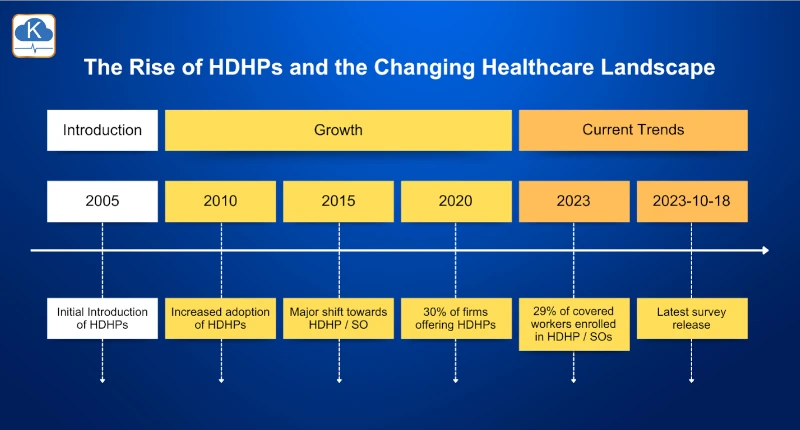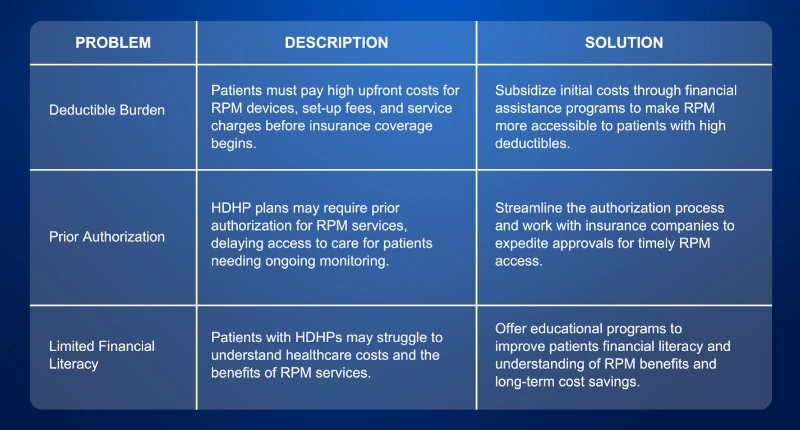Remote Patient Monitoring services are revolutionizing chronic disease management. This technology empowers healthcare providers to remotely track a patient’s health data, enabling proactive intervention and improved clinical outcomes. However, a significant barrier to wider adoption of RPM services lies in the growing prevalence of High Deductible Health Plans (HDHPs). With HDHPs requiring patients to shoulder a greater financial burden for their healthcare costs, the question arises: how do high deductibles impact access to RPM services?
This blog post explores the complex interplay between HDHPs and RPM services. We’ll delve into the potential benefits and drawbacks of HDHPs in the context of RPM, analyze the impact of high deductibles on patient access, and explore strategies to overcome these barriers.
What are High Deductible Health Plans?
High deductible health plans (HDHPs) are insurance policies with higher deductibles and lower premiums compared to traditional health plans. Under HDHPs, patients must pay a substantial amount out-of-pocket before their insurance begins to cover medical expenses. While HDHPs can lower monthly premiums, the high upfront costs can deter patients from seeking necessary medical care, including remote patient monitoring services.
The Rise of HDHPs and the Changing Healthcare Landscape
High Deductible Health Plans (HDHPs) have become increasingly popular in recent years. According to the Kaiser Family Foundation, in 2023, nearly half (49%) of covered workers in the United States were enrolled in an employer-sponsored health plan with a deductible of $1,500 or more. This shift towards HDHPs is driven by several factors, including:
- Lower Premiums: HDHPs typically offer lower monthly premiums compared to traditional health plans. This can be attractive to employers and employees alike, particularly for those seeking to manage healthcare costs.
- Consumer-Driven Healthcare: HDHPs promote a more consumer-driven approach to healthcare, encouraging patients to be more cost-conscious when seeking medical services.

Table from data from the 2023 Employer Health Benefits Survey conducted by the Kaiser Family Foundation (KFF) provides detailed insights into High-Deductible Health Plans with Savings Options (HDHP/SOs).
The rise of HDHPs has significant implications for healthcare providers and FQHCs, affecting patient access to care and increasing the financial and administrative burdens on these institutions. However, by leveraging RPM technology, providers can mitigate some of these challenges, improving patient engagement and outcomes while reducing overall healthcare costs. Addressing the barriers posed by HDHPs requires a multi-faceted approach, including patient education, policy advocacy, and the adoption of innovative technologies like RPM.
Potential Benefits of HDHPs for RPM Services
While concerns exist about the impact of HDHPs on access to care, there are also potential benefits in the context of RPM services:
- Cost-Effectiveness: RPM can be a cost-effective approach to managing chronic conditions by preventing avoidable hospital admissions and emergency room visits. For patients with HDHPs who carry a greater financial responsibility for their healthcare costs, the potential cost savings associated with RPM can be a significant incentive.
- Patient Engagement: The focus on cost-consciousness inherent in HDHPs can encourage patients to take a more active role in managing their health. RPM empowers patients to monitor their health data and collaborate with their healthcare providers, potentially leading to improved self-management of chronic conditions.
The Drawbacks of HDHPs: Potential Barriers to RPM Access
While HDHPs offer lower monthly premiums, they also present challenges that can impact access to RPM services. Understanding these drawbacks allows healthcare providers and policymakers to develop strategies to mitigate these barriers and enhance patient care.

Positive Steps Forward
Despite these challenges, there are actionable steps that healthcare providers, insurers, and policymakers can take to improve access to RPM services for patients with HDHPs:
- Financial Assistance Programs: Establish programs to help patients cover initial RPM costs, reducing financial barriers.
- Enhanced Patient Education: Provide comprehensive educational materials and workshops to ensure patients understand the value and use of RPM services.
- Policy Advocacy: Advocate for policy changes to classify RPM services as preventive care, thereby reducing out-of-pocket costs for patients.
By addressing these barriers proactively, healthcare providers can ensure that more patients benefit from the advantages of RPM services, leading to better health outcomes and more efficient chronic disease management.
Impact of Deductibles
The growing popularity of HDHPs presents a double-edged sword for healthcare providers. While HDHPs aim to control costs, they can also create barriers for patients managing chronic conditions. A 2011 study in Health Services Research found that even modest deductibles led to a slight decline in medication use for some chronic illnesses. This suggests patients may be delaying or skipping necessary treatments due to cost concerns.
Why Healthcare Providers Should Care:
For healthcare providers, this trend has significant implications:
- Reduced Adherence and Worsening Outcomes: When patients forgo medications or delay treatment due to high deductibles, the results can include uncontrolled chronic conditions, potentially resulting in more complex and expensive complications down the line.
- Increased Patient Burden: Patients managing chronic conditions may require more frequent monitoring and adjustments to their treatment plans. If they avoid seeking care due to cost concerns, it can create a heavier burden on providers in the long run.
- Missed Opportunities for Preventive Care: HDHPs can discourage preventive care like RPM services, which can play a crucial role in early detection and management of chronic conditions. This can ultimately lead to higher healthcare costs for both patients and the healthcare system.
The Role of Employers and Insurers in Promoting RPM Adoption
Employers and insurers play a crucial role in promoting the adoption of RPM services, even within the context of HDHPs. Here are some ways they can contribute:
- Plan Design and Coverage: HDHP plan designs can be structured to incentivize the use of RPM services. Incentives could involve offering lower deductibles or copays for RPM-related services, or including RPM as a preventive care benefit with no deductible.
- Wellness Programs and Incentives: Employers can integrate RPM into their wellness programs, offering financial incentives or rewards for employees who participate in RPM programs for chronic disease management. This can help offset the initial costs associated with HDHPs and encourage employee engagement.
- Value-Based Reimbursement Models: Insurers can adopt value-based reimbursement models that reward healthcare providers for positive health outcomes achieved through RPM, as opposed to simply fee-for-service models. Such rewards incentivize providers to invest in RPM technology and offer it to patients with HDHPs, cognizant of the potential cost savings associated with improved health outcomes.
The Future of RPM and HDHPs
The future of RPM services and their accessibility within the context of HDHPs hinges on a collaborative approach. Stakeholders across the healthcare ecosystem, including healthcare providers, insurers, employers, and policymakers, need to work together to:
- Develop cost-effective and sustainable models for RPM delivery.
- Increase patient education and awareness regarding the benefits of RPM.
- Advocate for policies that promote access to RPM services for patients with HDHPs.
Embrace Technology to Bridge the Gap
Technological advancements can play a significant role in bridging the gap between HDHPs and RPM access. Here are some promising areas of exploration:
- Telehealth Integration: Integration of RPM with telehealth services can provide a more comprehensive approach to chronic disease management. This can allow for remote consultations with healthcare providers, further reducing the need for in-person visits and associated costs.
- Remote Monitoring Device Innovation: Development of more affordable and user-friendly remote monitoring devices can make RPM more accessible to a wider range of patients with HDHPs. This includes exploring options for reimbursing or subsidizing the cost of these devices for patients who demonstrate a clear medical need for RPM.
How DrKumo Empowers Providers in the Face of Rising Deductibles
Rising deductibles in HDHPs pose a challenge for both patients and providers. Patients with chronic conditions, especially those who rely on medications or RPM services, may be deterred from seeking care due to upfront costs. This can lead to uncontrolled chronic conditions, increased patient burden, and missed opportunities for preventative care.
Healthcare providers need solutions to navigate these challenges and ensure their patients with chronic conditions receive the care they need. DrKumo empowers providers with the tools and resources to bridge the gap created by HDHPs. Our tiered pricing structure for the RPM platform makes it more accessible for patients, and we collaborate with providers to develop cost-sharing strategies.
Additionally, DrKumo provides educational resources for patients with HDHPs to address cost concerns and empower them to participate in their RPM program. By partnering with DrKumo, providers can confidently offer RPM services and optimize chronic disease management for all their patients, regardless of their insurance plan.
Takeaways
While high deductibles associated with HDHPs can create barriers to accessing RPM services, the potential benefits of RPM for chronic disease management and cost savings cannot be ignored. By implementing strategies that address cost concerns, promoting patient education, and fostering collaboration among stakeholders, the healthcare industry can work toward a future where HDHPs do not hinder access to this innovative technology.
Ultimately, expanding access to RPM services empowers patients with HDHPs to take a more active role in managing their health and paves the way for a more sustainable and cost-effective healthcare system for everyone.
Let DrKumo be your partner in navigating the complexities of HDHPs. Contact DrKumo today to explore our solutions and empower your patients with chronic conditions to thrive.









